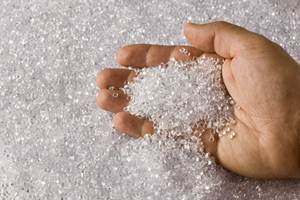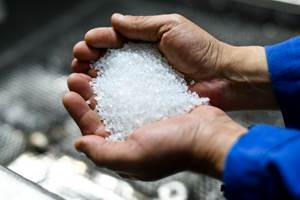Belt Polishing of Clear PP Film Proves Itself in Production
An unusual cast-film process that drops a melt curtain of polypropylene between a flexible steel polishing belt and a chill roll has now proven successful in high-volume commercial production.
An unusual cast-film process that drops a melt curtain of polypropylene between a flexible steel polishing belt and a chill roll has now proven successful in high-volume commercial production. This Sleeve Touch technology was unveiled at the K 2001 show in Dusseldorf. It wasn’t until last year that SML Extrusion Technology in Lenzing, Austria (U.S. offices in Atlanta), delivered its first two commercial Sleeve Touch extrusion lines to competing French companies for making PP film that is cut and folded into clear boxes for perfume bottles. One line makes monolayer film 700 mm wide. The other produces three-layer film 1400 mm wide. Both lines extrude high-clarity, heavy-gauge film aimed at replacing PET and PVC. PP’s advantage is softness, which gives an expensive feel to packages for high-value items. Polymers behave differently with Sleeve Touch, says Rupert Becker, product manager for sheet extrusion. “A 250-micron homopolymer PP film made by Sleeve Touch is a very soft film like a calendered random copolymer. Homopolymer PP is very difficult to calender.”
SML’s process can make PP film 100 to 400 microns thick. Normal cast PP film goes up to 250 microns and becomes hazy at more than 100 microns. Sleeve Touch film boasts better printability and thermoformability than standard PP cast film because it builds in little stress. PP sheet typically is at least 450 microns thick, and going any thinner than 350 microns imparts too much stress for thermoforming.
Sleeve Touch reportedly solves both haze and stress problems. The melt relaxes before it contacts the belt, then cools rapidly and evenly over a large belt area of 150 mm (MD) x 1450 mm (TD). With conventional chill rolls, most melt cooling occurs in a very narrow zone where it is compressed between the chill rolls. Belt sleeves extend that area of cooling under pressure and can emboss matte or smoky finishes, logos, or other motifs.
How long is belt life?
Before Sleeve Touch became commercial, it was not known how often the chromium-plated polishing belts would need to be replaced. “We don’t know how much the two French companies are running their machines,” says SML’s Becker, “but it’s not continuously. They both seem to need new belts every two to four months.”
SML’s 1400-mm-wide polished belt costs 11,000 Euros ($14,000) and takes about 30 minutes to change. Matte finishes and wider widths add cost—up to 15,000 Euros.
SML’s technology was originally licensed from Chiba Machine Industry Corp. in Chiba, Japan, which has over 20 machines in Japan making cosmetic packaging and office supplies. Those lines are small and low in output. Other machine builders have prototyped belt-polishing processes (see Learn More box), but SML is the only one yet to offer a commercial system that is scaled up for high outputs.
SML’s sleeves are getting bigger and cooling faster. Its first two Sleeve Touch lines make 700-mm and 1400-mm-wide film. SML now makes sleeves that produce film up to 1650 mm wide at up to 40 meters/min.
The belt’s cooling capacity has been augmented with the addition of three air knives and an increase in the diameter of the belt’s bottom cooling roll from 300 to 370 mm.
What’s ahead?
SML recently built its largest Sleeve Touch line yet for customer trials. It has three extruders and five-layer coex capability. The main extruder has 90-mm diam. and 33:1 L/D. The other extruders are 45 and 75 mm. SML has run trials for over 40 customers so far, including production runs of new films for test marketing.
Among several Sleeve Touch applications in development are coextruded PP/cyclo-olefin copolymer (COC) films for thermoformed pharmaceutical packages, decorative acrylic films for furniture lamination, high-clarity shrink films, and five-layer PP/EVOH barrier film for thermoforming clear, printable lids of food packages. SML says its PP barrier films are as clear as monolayer PP.
Sleeve Touch is also being used to develop in-mold decorating films for thermoforming into inserts for injection molding. These include silver-flake PP film with an automotive Class A finish and high-gloss nylon 6 and nylon 12 films for injection molded appliance parts.
Related Content
March 2025 Resin Pricing: Commodity Resin Prices Firm Up
Unplanned and planned production disruptions, rising feedstock costs and variables such as the potential impact of pending tariffs all factor in.
Read MorePrices Up for PE, PP, PS, Flat for PVC, PET
Trajectory is generally flat-to-down for all commodity resins.
Read MorePrices of PE, PP, PVC, PET Largely Firm, Flat for PS
By most measures, pricing for the five commodity resins appeared to be holding firm going into the third quarter.
Read MorePrices for All Volume Resins Head Down at End of 2023
Flat-to-downward trajectory for at least this month.
Read MoreRead Next
Lead the Conversation, Change the Conversation
Coverage of single-use plastics can be both misleading and demoralizing. Here are 10 tips for changing the perception of the plastics industry at your company and in your community.
Read MoreMaking the Circular Economy a Reality
Driven by brand owner demands and new worldwide legislation, the entire supply chain is working toward the shift to circularity, with some evidence the circular economy has already begun.
Read More









